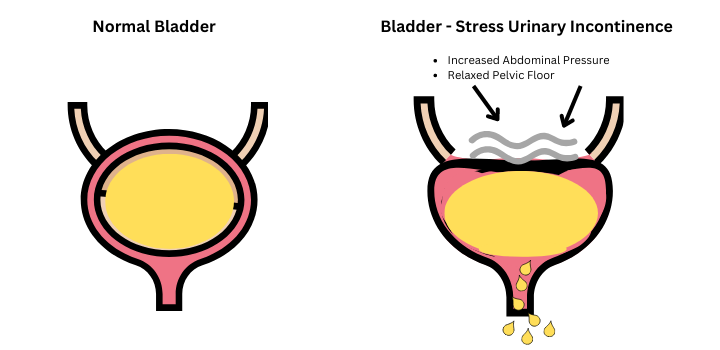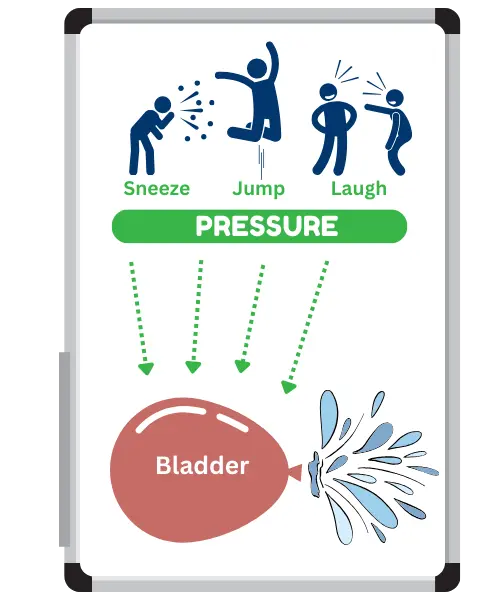Stress Urinary Incontinence:
Risk Factors, Causes and Solutions to Leakage.
Risk Factors, Causes and Solutions to Leakage.
Last week, I was with one of my clients and she was telling me about her weekend with her 5-year old. They were celebrating a birthday at a play centre. You know the ones with giant play structures and obstacle courses?
She was really excited to go to this birthday party but when she started jumping on the trampoline, guess what happened to her? She started peeing herself just after a few seconds! She was absolutely mortified! This is prime example of stress urinary incontinence. It happens often and it’s something we help our clients overcome every day.
I’ve been a Pelvic Floor Physiotherapist for over 13 years and today we’re going to address some of the most common topics and questions I get in the clinic about stress urinary incontinence.
What is it?
Stress Urinary Incontinence is the leaking of urine due to a sudden increase in abdominal pressure that puts stress on your bladder. If you laugh, cough, sneeze, jump or run and you notice any unwanted urine leak coming out, we call the stress urinary incontinence. It happens to one and three women at some point in their life and luckily for you there is so much that we can do about it.

Stress Urinary Incontinence and your bladder
How do I know I have Stress Urinary Incontinence?
Stress incontinence is encountered when there is a downwards pressure that’s happening in your body. If you are sneezing or jumping for example, you are putting downwards pressure on your bladder and your pelvic floor muscles. This could cause urine leakage. Stress incontinence affects both males and females, although females are generally more affected by this condition.
No matter how much (or how little) leaks out, it is still considered stress incontinence. It doesn’t matter if it only happens when your bladder is really full and just a drop comes out, if you are soaking through your underwear, or if you are relying on adult diapers, it is still considered stress incontinence! It’s very common for people to experience it, but it’s not normal and it can be fixed without the use of medication or diapers.

Actions like sneezing, jumping, laughing and couching contribute to the downwards pressure on your bladder.
Why does Stress Urinary Incontinence Happen?
1. Your Pelvic Floor Muscles Need Strengthening
The pelvic floor supports all your internal organs including: your uterus/prostate , your bladder, and your rectum. It may not be strong enough and it might not be generating enough tension upwards to offset the downwards pressure that’s coming down with the cough or sneeze. In this specific case, kegels or strengthening exercises may help to support those muscles.
2. Too Much Downwards Pressure
Imagine a pesky, chronic cough that just won’t go away. Now imagine the downward pressure generated by coughing multiplied 100+ times in a day. This can put excessive cumulative pressure on the bladder and the pelvic floor which could lead to leakage.
3. You are holding too much tension in your Pelvic Floor
When clients walk into our clinic for the first time, they always undoubtedly ask about kegel exercises (strengthening exercises). Just because you’re experiencing incontinence, doesn’t mean that your pelvic floor is weak! In fact, your pelvic floor muscles may actually be too tense. And in this case, kegel exercises might actually make your urine leakage worse! I’ll take some time to explain it in a bit more detail below:
- Imagine you are trying to scoop up a handful of water. You would want to cup your hand with adequate pressure between your fingers to make sure nothing leaks out.
- If your muscles were weak, and you held your hand completely relaxed, you wouldn’t be able to hold up that water. And what would happen is the water would start to dribble out from between your fingers.
- Now go ahead and make a fist with your hand. If you had lots of tension in your hand, the same thing would happen. The water would still dribble out and not be held effectively.
In many cases when we are working with pelvic floor tension, it’s not necessary to strengthen our pelvic floor muscles. The muscles are actually too tense and we need to think about trying to relax and lengthen the muscles a little bit more.

If your pelvic floor muscles are too weak or too tense, this can lead to urinary leakage.
4. Your Pelvic Floor Muscles aren’t coordinated
You may have good muscle strength and not be holding any tension in your pelvic floor muscles. But are you able to put them to use at the right time when they are needed? Another common factor in stress incontinence is controlling these muscles at the right time and with the appropriate sequence.
In these cases, the pelvic floor muscles may actually be late to turn on or may not be contracting at the right time, before the downwards pressure hits your bladder.
Learning how to better coordinate your pelvic floor will ensure you can offset that downwards pressure from a cough or a sneeze.
Why do I have Stress Urinary Incontinence? Common Risk Factors
Different risk factors usually drive why certain people experience stress urinary incontinence. The seven most common ones I see in my practice include: pregnancy, surgery, high-intensity sports, chronic coughing, heavy lifting, aging, and genetics.
Risk Factor #1: Babies
Stress incontinence is talked about a lot in relation to having babies. If you are currently pregnant, recently delivered or have adult children, you are likely to experience stress incontinence. Unfortunately, it’s one of those things that is often brushed off as “normal” when you have kids. In general, you are at higher risk of developing stress urinary incontinence if:
- You’ve had a vaginal delivery
- You’ve had a heavy or large baby
- You’ve had multiple babies
- You’ve had instrumentation (ie. forceps and vacuum) used during delivery
Risk Factor #2: Surgery
Certain surgeries can increase your risk of experiencing stress urinary incontinence. In general, tissues and organs are altered, moved around, and repositioned. This will result in scar tissue formation and may also change the way the pelvic floor functions.
In males, prostate surgery is one of the most common risk factors for developing stress incontinence.
Radical prostatectomy is one of the most common surgical procedures for men with prostate cancer. When the prostate gland is removed, the ability for the pelvic floor muscles to continue to hold in urine becomes altered and may result in urinary incontinence.
A TURP (transurethral resection of the prostate) is a surgical procedure to treat BPH (benign prostatic hyperplasia), a non-cancerous enlargement of the prostate gland. The purpose of this procedure is to relieve symptoms such as slow urine stream and difficulty initiating urination by removing some excess prostate tissue. In some cases, urinary incontinence can be experienced after this procedure.
In females, gynecological surgery can be a contributor to urinary incontinence.
A hysterectomy is where the uterus is removed (with or without the cervix, ovaries, and fallopian tubes). It can be performed for a variety of reasons including for heavy bleeding, large fibroids, or to remove cancer. When the uterus is removed, there will undoubtedly be changes to the anatomy and structure of the pelvic organs and pelvic floor which can result in incontinence.
Surgical repair of a pelvic organ prolapse can also result in urinary incontinence. During a prolapse repair, the pelvic organs are lifted and repositioned in the pelvis to decrease the amount of pressure on the vaginal canal. Urinary incontinence can sometimes be a side effect of this procedure.
Risk Factor #3: High Intensity Sports
If you haven’t had surgery and you haven’t had kids and you’re still having leakage, we know that stress incontinence is also associated with high intensity athletes. We see a lot of athletes in sports such as gymnastics, cheerleading and figure skating to name a few.
In general, these are typically sports that require you to hold your body tight with a lot of tension. They are also associated with lots of downward force. Tumbling and jumping generates a lot of cumulative downwards pressure on the pelvic floor and can cause leakage.
Risk Factor #4: Chronic Cough
We have all probably experienced a bit of a chronic cough at some point, especially in this post-Covid world we are in. But this becomes more of an issue if you have also dealt with allergies, other respiratory conditions like COPD (chronic obstructive pulmonary disease), or have experienced one or more of the other risk factors on this list! The cumulative downwards pressure on the pelvic floor can put more pressure on your bladder over time and can cause more leakage.
Risk Factor #5: Repetitive Heavy Lifting
If you are constantly doing heavy lifting at work, in the garden, or at the gym, that puts you at risk for stress urinary incontinence as well. Most of us tend to hold our breath, or perform what’s known as a Valsalva manoeuvre when we lift something heavy, and this in turn creates more downward force through our body which can cause leakage as well.
Risk Factor #6: Ageing
In both males and females, as we age, our muscles get weaker and our muscles don’t have as much bulk to them. This limits the supportive function of the pelvic floor and can contribute to bladder leakage. In females, add changes to menopause on top of that and it affects the pelvic floor even more.
Risk Factor #6: Genetics
Unfortunately, there is often a genetic predisposition to pelvic floor disorders, including Stress Urinary Incontinence. So if you know that your mom and your grandma had issues with leaking, that should be even more of a reason to seek help early.
How Can I Fix It?
So now that we’ve talked about a number of different reasons why leakage might be happening, the big question becomes “what can I do about it”?
The healthcare and medical communities across North America agree that Pelvic Floor Physiotherapy is considered the first line of defence for stress incontinence. Evidence-based research shows that pelvic floor physiotherapy is a safe and effective way to treat stress urinary incontinence.
A pelvic floor physiotherapy assessment consists of 3 main parts: a section where we chat about your medical history and current concerns, a movement assessment, and a pelvic floor assessment. We go through a full examination that may include your back, hips and how you’re moving around. Then we assess your pelvic floor muscles to determine what is causing your stress urinary incontinence.
This full examination will allow us to address the root cause of your incontinence. So if your pelvic floor muscles are weak; we’ll help develop strategies and a plan to strengthen those muscles. If we find that you’re holding a lot of tension in your muscles, we provide strategies to help relax, lengthen, and develop flexibility in your pelvic floor muscles.
If you’re facing other issues like scar tissue discomfort, prolapse, or coordination issues, we address those. And if we need to work on lifting mechanics, movement patterns with jumping, or running pattern, we work on that too! Addressing stress incontinence is rarely just working on the pelvic floor, but looking at the whole body and all the factors that can be influencing its function.
Now that you have a better sense of the ‘what’, ‘how’, and ‘why’ about stress incontinence, the best thing to do is check in with a pelvic floor physiotherapist who is trained in assessing and treating the pelvic floor. This is really considered the gold standard of care in order to determine what’s happening with your pelvic floor and what steps need to be taken to cure this common, but not normal problem!



